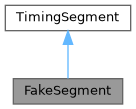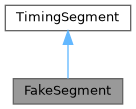|
| auto | GetType () const -> TimingSegmentType override |
| |
| auto | GetEffectType () const -> SegmentEffectType override |
| |
| auto | Copy () const -> TimingSegment *override |
| |
| auto | IsNotable () const -> bool override |
| |
| void | DebugPrint () const override |
| |
|
| FakeSegment (int iStartRow, int iLengthRows) |
| |
|
| FakeSegment (int iStartRow, float fBeats) |
| |
|
| FakeSegment (const FakeSegment &other) |
| |
|
auto | GetLengthRows () const -> int |
| |
|
auto | GetLengthBeats () const -> float |
| |
|
auto | GetLength () const -> float |
| |
|
void | SetLength (int iRows) |
| |
|
void | SetLength (float fBeats) |
| |
| void | Scale (int start, int length, int newLength) override |
| | Scales itself.
|
| |
| auto | ToString (int dec) const -> std::string override |
| |
| auto | GetValues () const -> std::vector< float > override |
| |
|
auto | operator== (const FakeSegment &other) const -> bool |
| |
| auto | operator== (const TimingSegment &other) const -> bool override |
| |
|
| TimingSegment (int iRow=ROW_INVALID) |
| |
|
| TimingSegment (float fBeat) |
| |
|
| TimingSegment (const TimingSegment &other) |
| |
|
auto | GetRow () const -> int |
| |
|
void | SetRow (int iRow) |
| |
|
auto | GetBeat () const -> float |
| |
|
void | SetBeat (float fBeat) |
| |
|
auto | operator< (const TimingSegment &other) const -> bool |
| |
|
virtual auto | operator!= (const TimingSegment &other) const -> bool |
| |
Identifies when a whole region of arrows is to be ignored.
FakeSegments are similar to the Fake Tap Notes in that the contents inside are neither for nor against the player. They can be useful for mission modes, in conjunction with WarpSegments, or perhaps other uses not thought up at the time of this comment. Unlike the Warp Segments, these are not magically jumped over: instead, these are drawn normally.
These were inspired by the Pump It Up series.


 Public Member Functions inherited from TimingSegment
Public Member Functions inherited from TimingSegment Static Public Attributes inherited from TimingSegment
Static Public Attributes inherited from TimingSegment